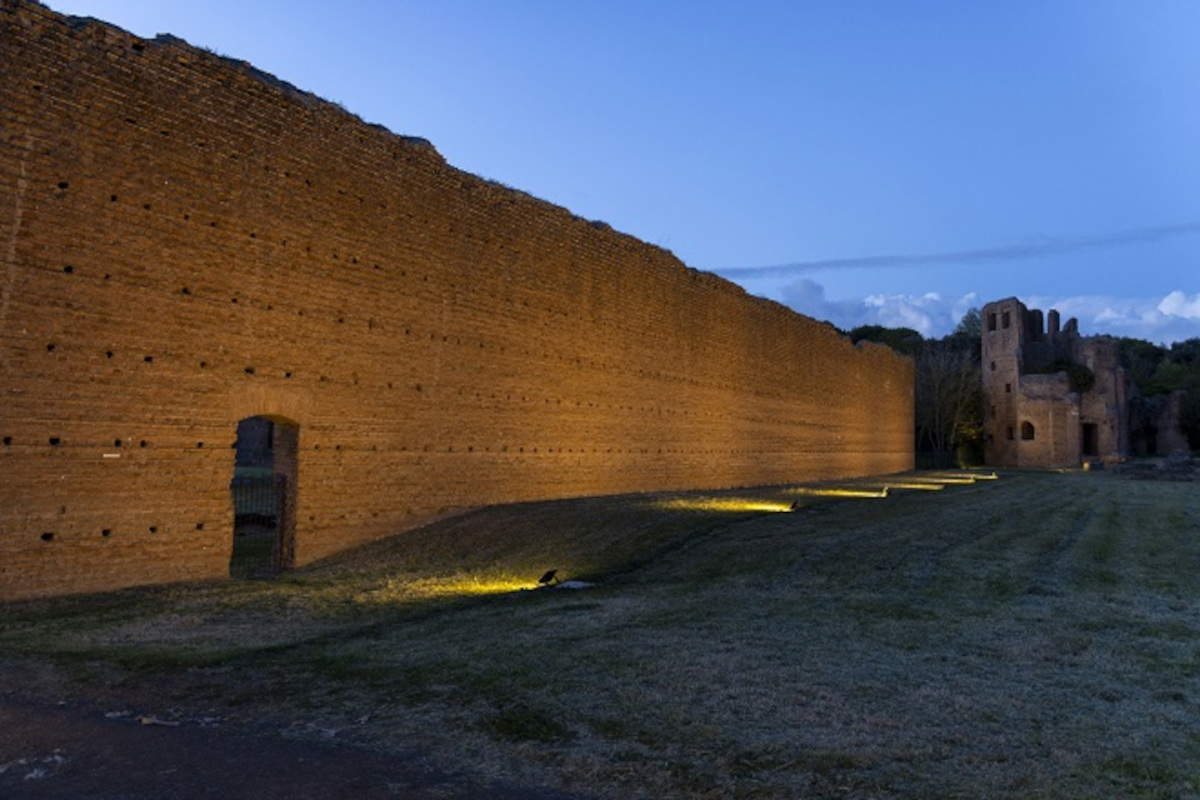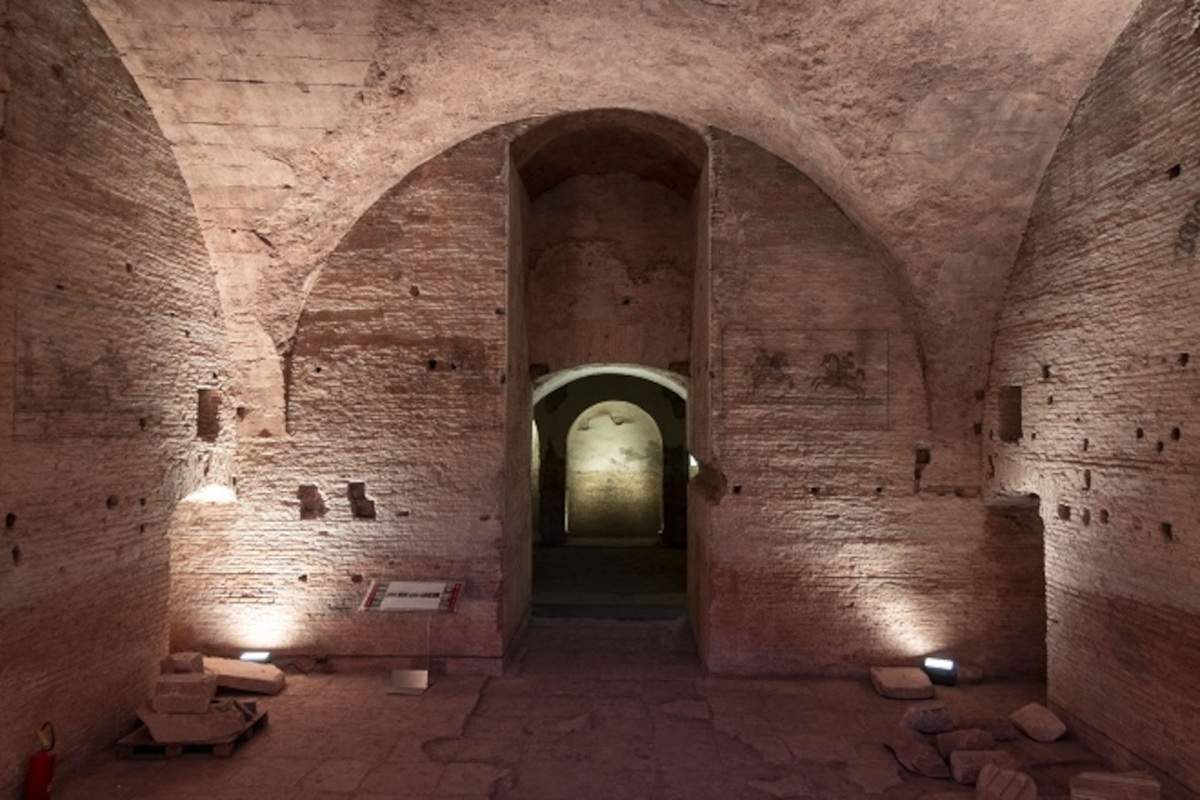The new artistic lighting system of the Villa of Maxentius on theAppia Antica, among the city’s most significant archaeological sites, was inaugurated on the occasion of the celebrations for Rome’s 2777th birthday. This intervention has made it possible to further enhance the remains of some symbolic sites of ancient Rome, such as the Imperial Palace, the Circus and the Mausoleum of Romulus, making them visible even during the evening hours and allowing the public to appreciate their beauty even after sunset.
The work, carried out by the Capitoline Superintendency of Cultural Heritage thanks to the support of Lotus Production Srl S.U/Libra, initially involved the maintenance of the pre-existing lighting system at the dynastic mausoleum and inside the funerary crypt. Next, new lighting was created along the access path to the archaeological area, on the towers of the Circus carceres and on the exterior facade of the quadriporticus surrounding the mausoleum area. Thanks to this intervention, it is now possible to visit the monumental complex free of charge even in the evening. The Villa of Maxentius is one of eight museums in the Musei in Comune di Roma Capitale network managed by Zètema Progetto Cultura, and in 2023 alone it welcomed more than 61,000 visitors.
For the summer of 2024, extraordinary Saturday evening openings are planned, while the opening hours will also be extended during free Sundays (first Sunday of the month), with the aim of decongesting the most crowded sites and monuments during these occasions, encouraging greater attendance in this area rich in archaeological monuments. In addition, small concerts, readings, lectures and other cultural events will be organized on some of these special evenings.
The lighting system is just the latest in a series of interventions that the Capitoline Superintendence has carried out in recent years within the impressive archaeological site with the aim of enhancing services, accessibility and knowledge of the area. Indeed, in 2019, a major conservative restoration of the Cenci Arch was carried out, which involved the recovery of interior and exterior spaces. Currently, one of these spaces is the subject of an ongoing set-up to house a multimedia room dedicated to welcoming visitors. In 2022, information tools were expanded with tactile panels for the blind and visually impaired, providing descriptions of the area and the Via Appia Antica, thus improving accessibility for all visitors. In 2024, thanks to the PNRR’s Caput Mundi - Next Generation EU Program, a major restoration and rehabilitation of structures in the monumental complex will be launched. This intervention will further expand the visitable areas, including the Pulvinar area, the imperial stage from which the Emperor followed the races and games in the Circus. A barrier-free route will make this area accessible to all visitors. Also included in the Caput Mundi program is an additional project to enhance the area of the Villa of Maxentius, which will allow the public to deepen their knowledge of the spaces through the use of advanced digital technologies, thus expanding their understanding of the extent, history and architectural features of the site.
Among the most striking archaeological areas in the Roman countryside, the Massentian complex stretches between the 2nd and 3rd miles of the Appian Way and consists of three main buildings: the palace, the circus and a dynastic mausoleum, designed as a single architectural unit to celebrate Emperor Maxentius, the opponent of Constantine the Great at the Battle of Ponte Milvio in 312 AD. The pattern of the circus combined with the imperial palace, already known from other residences, is here accompanied by the presence of a dynastic mausoleum, known as the Tomb of Romulus, named after the very young son of Maxentius who was almost certainly buried here. The circus, still well preserved in all its architectural components, could seat more than 10,000 spectators, and at its center stood the Obelisk of Domitian, which centuries later was reused by Gian Lorenzo Bernini in the Fountain of Rivers.
The central core of the entire complex was the dynastic mausoleum. The grandiose building, probably two stories high, must have had the appearance of a small Pantheon and was surrounded by an imposing quadriporticus that connected it with the palace built on the hill behind. All that is preserved of its original construction is the circular basement and the crypt, with a large central pillar and an annular corridor in which the niches for the deposition of sarcophagi opened. From the annular corridor it is possible to enter a large quadrangular vestibule, which was probably used to reach the upper floor.
It is assumed that the area, formerly part of the Triopio of Herod Atticus, had been incorporated, like other areas of the suburb, into the imperial domain. With the defeat of Maxentius, it is likely that the Maxentian buildings passed to the Church of Rome and thus, at least from the 6th century onward, were part of the Patrimonium Appiae. For centuries information about the area was patchy and the monuments divided among different owners. In the 19th century the whole complex was acquired by the Torlonia family, dukes of Bracciano. In 1825 Prince Giovanni Torlonia started excavation campaigns in the area with the help of archaeologist Antonio Nibby, transferring the many works of art found in the private collection of the Borgo palace and transforming the estate into a farm, a destination that lasted until the expropriation in 1943.
Photo by Monkeys Studio Lab.
For info: www.villadimassenzio.it
Free admission


 |
| Rome, inaugurated the new artistic lighting of the Villa of Maxentius. It can now be visited at night |
Warning: the translation into English of the original Italian article was created using automatic tools. We undertake to review all articles, but we do not guarantee the total absence of inaccuracies in the translation due to the program. You can find the original by clicking on the ITA button. If you find any mistake,please contact us.